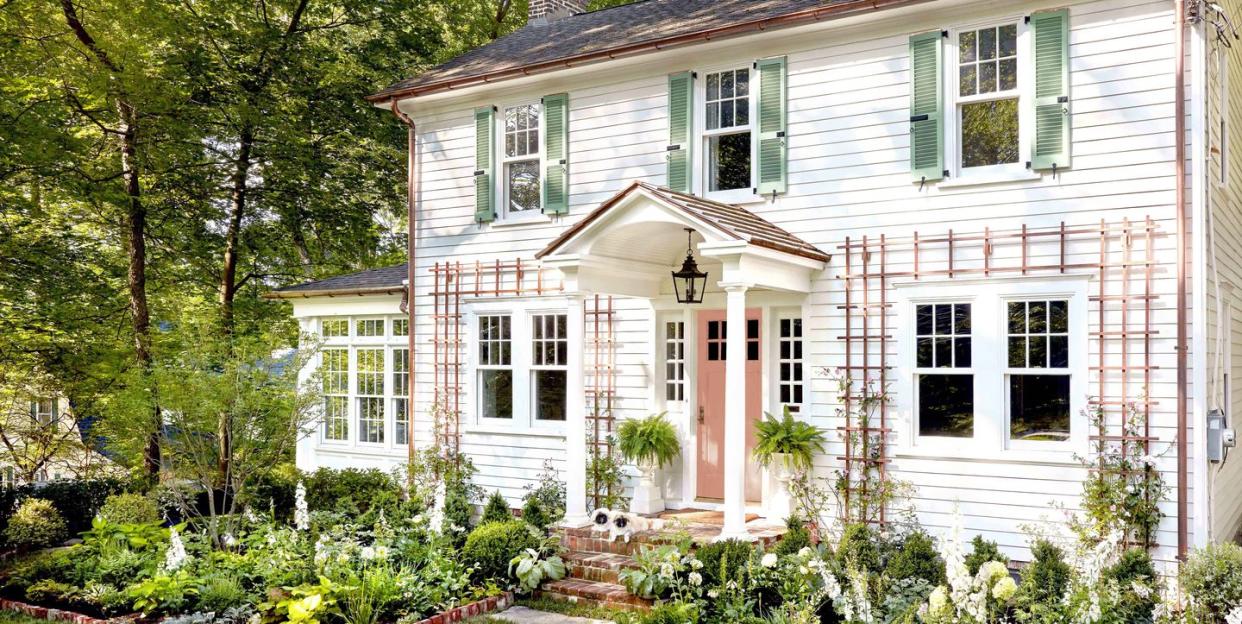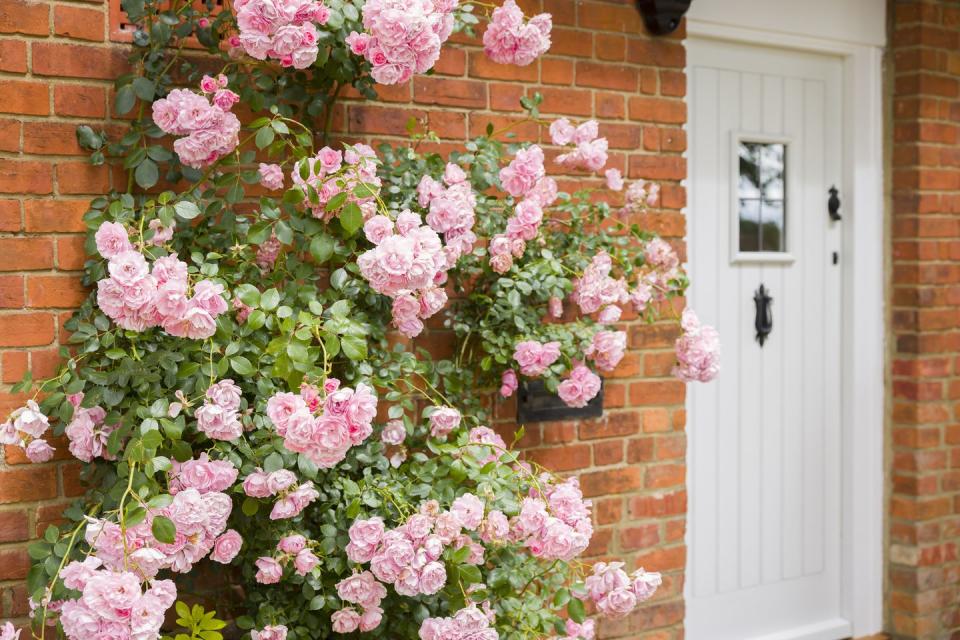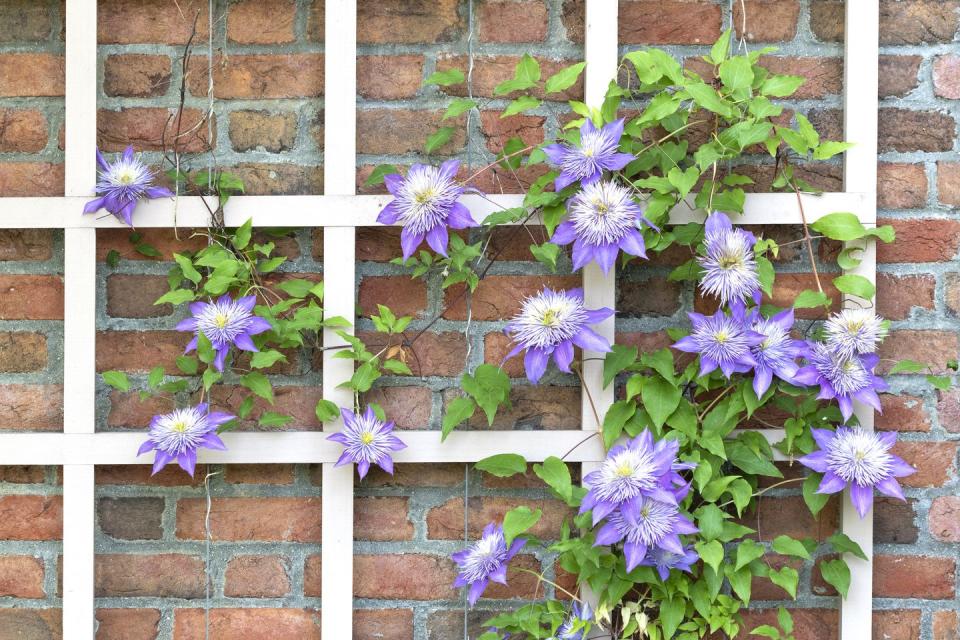How to Grow Gorgeous Climbing Vines On Your House

Vine-covered walls have an unmistakable allure, evoking lazy afternoons sitting in a cozy English garden or lounging on the patio of a sunny Mediterranean villa. They can also give your house serious curb appeal. The good news is that training ivy or flowering vines and plants to climb up your house isn't difficult, and it adds timeless appeal and style. "Vines can be such dynamic and beautiful addition to an outdoor space," says landscape designer Kat Aul Cervoni, founder of Staghorn NYC, and The Cultivation by Kat. "I recommend incorporating them whenever possible."
But while vines don't require tons of skill, they do require a little patience and careful consideration to make sure you're choosing the right type. It takes time and a little effort to train vines up walls, and there are some types you should never plant. "Some vines can be invasive and are not recommended," says Cervoni. "In fact, many vines are not suitable for home gardens unless you have an experienced gardener who is consistently maintaining and managing them." (Since you probably don't have a professional gardener on-staff, you should never plant these invasive plants.)
It's also important to note that, like most things, climbing vines take time to mature. A vine-draped home is not going to happen overnight! "The rate at which a vine can cover a wall very much depends on the type of vine used, and the size of the wall," says Cervoni. "It’s not unheard of for Virginia creeper, which is hard to control because it's so fast growing, to put on 20 feet of growth in a single year once established. But other vines, such as climbing hydrangea, creep slowly, putting on just 1 to 3 feet per year."
Planting vines to climb up your house is a long-term commitment, not an overnight transformation. But if you're patient and choose the right plant, you’ll be rewarded with dreamy vine-covered walls in a few years. Don't forget that for perennial vines, you must also choose a type that can survive winters in your USDA Hardiness zone (find yours here).
Read on for answers to all your questions about how to grow ivy and vines up your walls—without damaging your home.
How do climbing vines cling?
Vines climb by supporting themselves with twining stem, aerial rootlets, or adhesive disks—and you have to know what kind of support your vine of choice needs. "It's crucial to match the support system with how the vines climbs," says Miranda Niemiec, operations manager and horticulturalist for GreatGardenPlants.com. "Twining plants need a sturdy support with narrow 'bars' that they can wind around." This means you'll want to have a trellis, lattice, or ironwork for plants such as honeysuckle, kiwi vine, and bougainvillea to climb up.
Other vines, such as climbing hydrangea, use small aerial rootlets to cling, so they don't need much help and will climb well on their own, especially on rough surfaces such as masonry. One caveat: "If you choose this type of vine, know that if you decide to remove it someday, its aerial rootlets will stay behind and need to be sanded or power-washed off," says Niemiec.
The most difficult types of vine to remove are those that attach themselves with adhesive disks, like Boston Ivy and Virginia creeper. These pose a real threat to homes—if a vine is torn off, the suction-cup-like disks often pull out chunks of masonry as well, leaving holes behind.
Will climbing vines damage my walls?
It depends on the type of vine—as described above—but also on the home. "There are some surfaces I do not recommend training a vine onto as there is too much risk that damage will occur," says Cervoni. "Homes with vinyl siding, wood siding, and wood shingles should be kept vine-free because the tendrils can creep underneath or between slats, causing them to pull away from the home, introducing moisture beneath the siding."

What are the best vines to train up a wall?
Climbing hydrangea (Hydrangea anomala petiolaris) has good shade tolerance, lovely flowers, and foliage that stays pretty even in the heat; it is self-clinging, says Cervoni.
Carolina jessamine (Gelsemium sempervirens) is a tough, fast-growing evergreen vine that has beautiful bright yellow spring flowers; it’s tolerant of light shade. It’s twining, so it needs a support or trellis, says Cervoni.
Kiwi vine (Actinidia kolomikta) is an unconventional choice with fragrant flowers and pretty variegation, says Niemiec.
Roses (Rosa), such as New Dawn, require a tad more upkeep and will need support, such as a trellis. But they're a beautiful, fragrant addition to any garden space, says Cervoni.
Bougainvillea (Bougainvillea) has tiny white flowers surrounded by gorgeous, papery bracts in bright colors. It's a stunning perennial vine in warm climates. "It needs a little help from you to climb," says Niemiec. "You'll need to guide it up a trellis, then check its growth periodically so that it continues to twine in the direction you want."
Clematis (Clematis) is available in many different varieties and colors; its petioles, the little stem that connects the leaf to the main stem, wrap around the support structure, so it needs narrow upright supports such as heavy-duty coated wire to climb, says Niemiec.

What vines should you avoid training up a wall?
There are several vines that aren't a good idea to plant because they are considered invasive or will damage your home’s surface. Many of these still are sold at nurseries and online, so read labels and look for the botanical name to be sure about what you’re buying.
Vines you should avoid planting to climb your home’s walls include:
English ivy (Hedera helix) can damage mortar and become invasive, says Cervoni. If you love the look of ivy, stick to it as a potted houseplant, where it won't take over—although it may start breeding spider mites.
Wisteria, including Wisteria sinensis and Wisteria floribunda, is considered invasive. If you have your heart set on wisteria, use the native North American species, Wisteria frutescens, says Niemiec. 'Amethyst Falls' is a popular native variety.
Trumpet vine (Campsis radicans) is a vigorous climber that can become a maintenance nightmare, says Niemiec.
Wintercreeper (Euonymus fortunei) can become invasive in a garden and also spread by wind to open natural areas where it can take over, says Cervoni.

How do you get a vine to climb up a trellis or wall?
Some plants, such as climbing roses and bougainvillea, may need some help from you to get started. "For example, gently weave the rose through the support so it can start growing in the right direction," says Cervoni. "If a vine is too small, use twist ties, garden twine or outdoor-rated hook and loop fasteners, such as Velcro, to secure it to the trellis." A thin metal wire attached to the wall with eye hooks also works to serve as a support.
You'll need to check on your vine periodically during the growing season to make sure it's going in the right direction. Redirect any wayward growth by weaving it into the trellis or securing with twine, says Cervoni. Perennial vines also benefit from yearly pruning to maintain shape or to promote better blooming.
If perennial vines seem like too much effort to maintain year after year, consider planting an annual vine, says Niemiec. There are tons of options, including morning glory, moonflower, vining types of nasturtium (not mounding types), black-eyed Susan vine, and scarlet runner bean, which has lovely red flowers hummingbirds love and edible beans. You'll get all the beauty and color—plus attract pollinators—with annual vines, plus the added flexibility of knowing you can change up what type of vine you grow every year.
You Might Also Like

